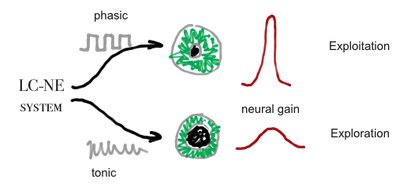Pupil response is governed by the autonomic nervous system. Pupil dilation depends on the activation of the adrenergic sympathetic nervous system, while pupil constriction depends on the cholinergic parasympathetic nervous system[1]. It has been well documented that pupil response is modulated not only by an ambient luminance level (the so-called pupil light reflex) but also by the amount of mental effort invested in a task [2][3][4][5][6][7][8][9][10][11][12]. For example, Porter et al[13] reported that the pupil dilates when subjects conduct a difficult visual search task in which high mental effort has to be invested.
Pupil size is thought to be controled by the LC-NE system
References
- ↑ Barbur J (2004) Learning from the pupil: studies of basic mechanisms and clinical applications. The Visual Neurosciences Vol. 1. In: Chlupa L, Werner J, editors. Cambridge: The MIT Press. pp. 641–656.
- ↑ Beatty J (1982) Task-evoked papillary responses, processing load, and the structure of processing resources. Psychological Bulletin 91: 276–292. doi: 10.1037/0033-2909.91.2.276
- ↑ Hampson RE, Opris I, Deadwyler SA (2010) Neural correlates of fast pupil dilation in nonhuman primates: relation to behavioral performance and cognitive workload. Behavioral Brain Research 212: 1–11.
- ↑ Kahneman D, Beatty J (1966) Pupil diameter and load on memory. Science 154: 1583–1585. doi: 10.1126/science.154.3756.1583
- ↑ Kahneman D, Peavler W (1969) Incentive effects and papillary changes in association learning. Journal of Experimental Psychology 79: 312–318.
- ↑ Partala T, Surakka V (2003) Pupil size variation as an indication of affective processing. International Journal of Human-Computer Studies 59: 185–198. doi: 10.1073/pnas.88.11.4966
- ↑ Porter G, Troscianko T, Gilchrist I (2007) Effort during visual search and counting: insights from pupilometry. The Quarterly Journal of Experimental Psychology 60: 211–229. doi: 10.1080/17470210600673818
- ↑ van Orden KF, Jung T-P, Makeig S (2000) Combined eye activity measures accurately estimate changes in sustained visual task. Biological Psychology 52: 221–240. doi: 10.1016/S0301-0511(99)00043-5
- ↑ van Orden KF, Limbert W, Makeig S, Jung T-P (2001) Eye activity correlates of workload during visuospatial memory task. Human Factors 43: 111–121. doi: 10.1518/001872001775992570
- ↑ Heaver, Becky, and Sam B. Hutton. "Keeping an eye on the truth? Pupil size changes associated with recognition memory." Memory 19.4 (2011): 398-405.
- ↑ Silvetti, Massimo, et al. "The influence of the noradrenergic system on optimal control of neural plasticity." Frontiers in behavioral neuroscience 7 (2013).
- ↑ Takeuchi, Tatsuto, et al. "Estimation of Mental Effort in Learning Visual Search by Measuring Pupil Response." PloS one 6.7 (2011): e21973.
- ↑ Porter G, Troscianko T, Gilchrist I (2007) Effort during visual search and counting: insights from pupilometry. The Quarterly Journal of Experimental Psychology 60: 211–229. doi: 10.1080/17470210600673818
